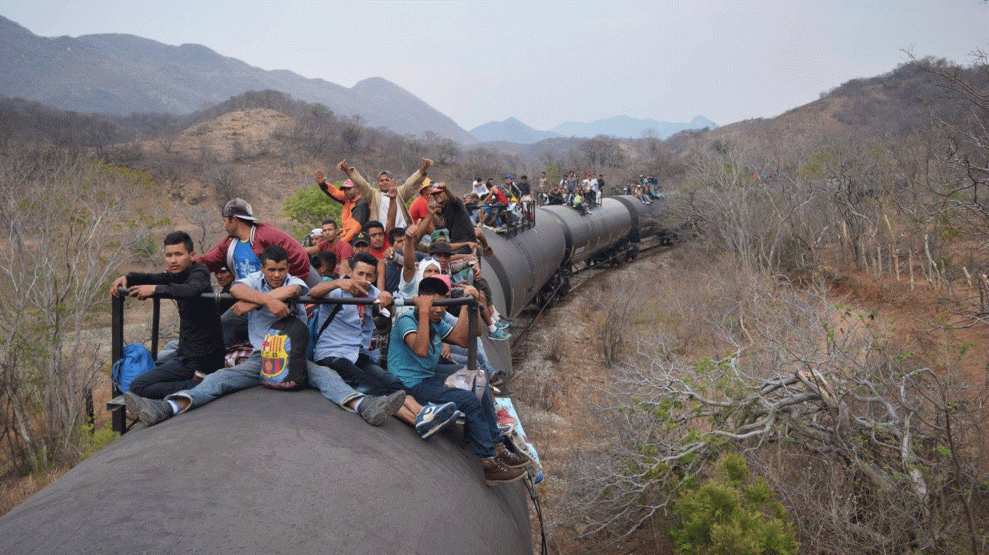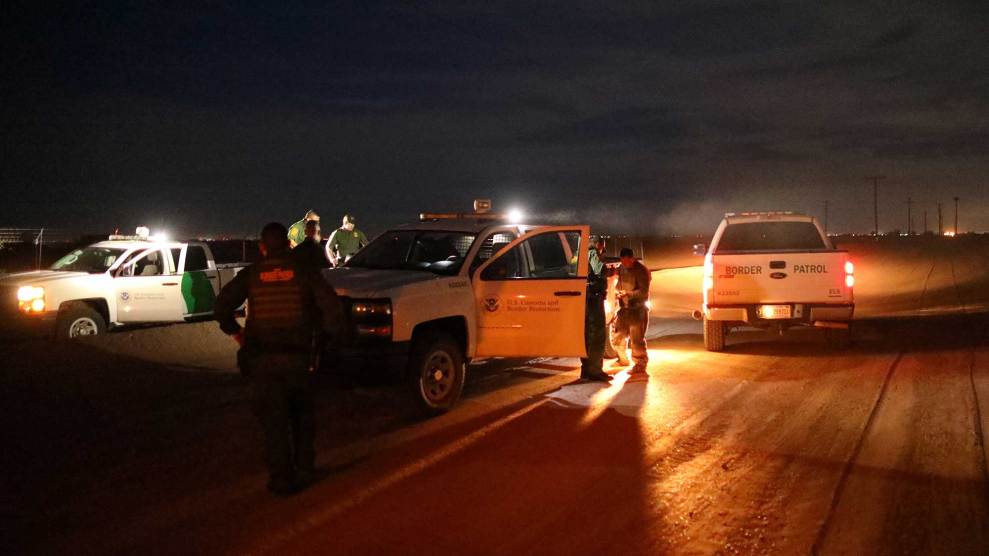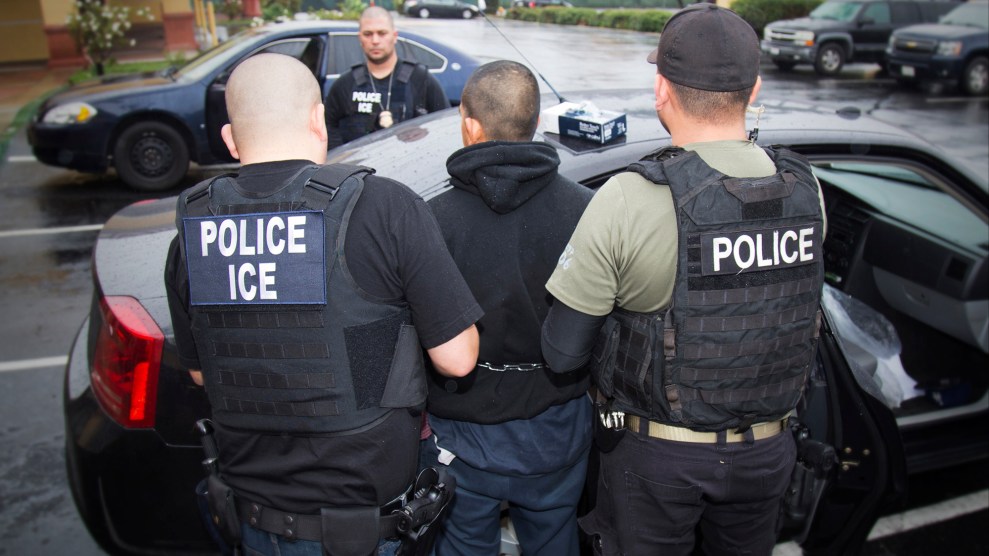
Refugees from the migrant caravan riding on the Mexican rail line known as "La Bestia" (The Beast).Cristobal Sanchez
At this moment, a group of 200 refugees fleeing violence and gangs in Central America are heading north through Mexico in hopes of seeking asylum when they reach the US border later this week. The caravan, which has been planned with a coalition of Mexican and American organizers, is meant to raise awareness of the perils facing migrants in Mexico as well as the Trump administration’s efforts to prevent refugees from legally entering the United States.
It’s been an eventful journey. On April 9, the group of men, women, and children crossed the Suchiate River into Mexico from Tecún Umán, Guatemala. Since then, they have journeyed atop La Bestia, also known as “The Beast” and “The Train of Death,” the notoriously dangerous network of freight trains that migrants use to traverse Mexico. They’ve escaped a standoff with Mexican immigration agents in Veracruz. Two weeks ago, a Mexican-American immigration activist named Hugo Castro went to meet the caravan, and disappeared after posting a cryptic video saying that criminal groups were “hunting” him. He was found five days later and admitted to a hospital with serious injuries and potential brain damage. Then, in Mexico City, someone sabotaged a vehicle transporting some of the refugees, causing one of the wheels to fly off, according to one of the caravan’s organizers.
They may face another obstacle at the American border. Since the election of President Donald Trump, Customs and Border Protection (CBP) officials have allegedly been turning back asylum seekers at an alarming rate. According to multiple human rights lawyers and observers, CBP officials at border crossings have denied entry to refugees on a variety of pretexts. Some asylum seekers have been told they need paperwork from the Mexican immigration agency or that they’ll have to come back later because officials don’t have time to process them. Others have been told that the United States is no longer accepting people from their country or that it’s only admitting refugees from countries where Christians are being persecuted.
Nicole Ramos, an American human rights attorney working in Tijuana, has accompanied nearly 70 asylum seekers to the American border over the past year. CBP refused to process many of them. Border officials, she says “act like they are giving these people something from their own pocket, like these people are asking to go live in their own living room or something, or that they’re all coming in loaded up with 10 kilos of coke and an automatic rifle. They’re humble people, most of whom don’t have any criminal history. They’re survivors of profound trauma, who don’t speak English or understand anything about the legal system.”
“After the elections and through now, CBP is feeling much more empowered. It’s, ‘Trump doesn’t want you here. It’s a new administration,'” says Daniella Burgi-Palomino, a senior associate at the Latin America Working Group. Ramos echoes these claims. “After the election, things started getting more hostile. After Trump, they started feeling emboldened.”
Under US and international law, border agents must admit asylum seekers to review their cases and evaluate whether they have “credible fear” of returning to their home country if they are not admitted. In an email, CBP spokesman Carlos Diaz said, “CBP has not changed any policies affecting asylum procedures,” and that its officers are required to give any migrant who “expresses fear of being returned to his/her home country” an interview with an asylum officer.
Not only is turning away asylum seekers illegal, it may also put vulnerable migrants in immediate danger. “The northern side of the Mexico border is extremely dangerous,” says Leah Chavla, a human rights lawyer with the Women’s Refugee Commission. “There are mass graves where migrants have been executed. They have been disappeared. The Mexican authorities are no source of protection to anyone there.”
Mexico’s powerful drug cartels have made a practice of kidnapping refugees for ransom, according to several experts. In one recent case, a single mother who had faced death threats in Guatemala and survived a serious car accident on the journey north was turned back by CBP at the border crossing between Reynosa, Mexico and McAllin, Texas. “She didn’t even finish crossing the bridge before she was kidnapped,” says Burgi-Palomino. The woman was released three weeks later after her family paid a ransom.
So far, the refugee caravan’s strength in numbers and organization has been crucial. Its members have set up security and logistical teams and tried to keep criminals from infiltrating the group. The caravan was surrounded by 80 Mexican immigration agents while riding on top of La Bestia, a common occurrence for migrants. Typically, says Alex Mensing, a paralegal at the University of San Francisco’s Immigration and Deportation Defense Law Clinic who is one of the organizers of the caravan, says, “they surround the train in a remote area, they pull everybody off, and in some cases they end up extorting people, detaining them, and sometimes they are collaborating with organized crime.” But the caravan avoided being delayed or detained. The group chanted protest slogans (“Migrants are not criminals, we are international workers”). One of two organizers traveling with the group shot a live Facebook video during the stand-off, and eventually the immigration officers went away.
Once the caravan arrives in Tijuana, the participants and organizers have planned a day of activities drawing attention to why its members fled their home countries and why this effort was necessary put pressure on both the United States and Mexico. “There is a refusal on the parts of the Mexican and the US governments—and the Mexican government on behalf of the US government—to deal with the Central American exodus as a refugee crisis,” Mensing says.
A day later, on May 7, if all goes according to plan, the refugees hope to line up at the border crossing to seek asylum in the United States. “I don’t know to what extent CBP will push back,” Mensing says. “I don’t anticipate that they will, but it just depends on how willing the current administration is to crack down directly on Central Americans asserting their rights as asylum seekers. Our plan is that everyone is going to get let in.”














